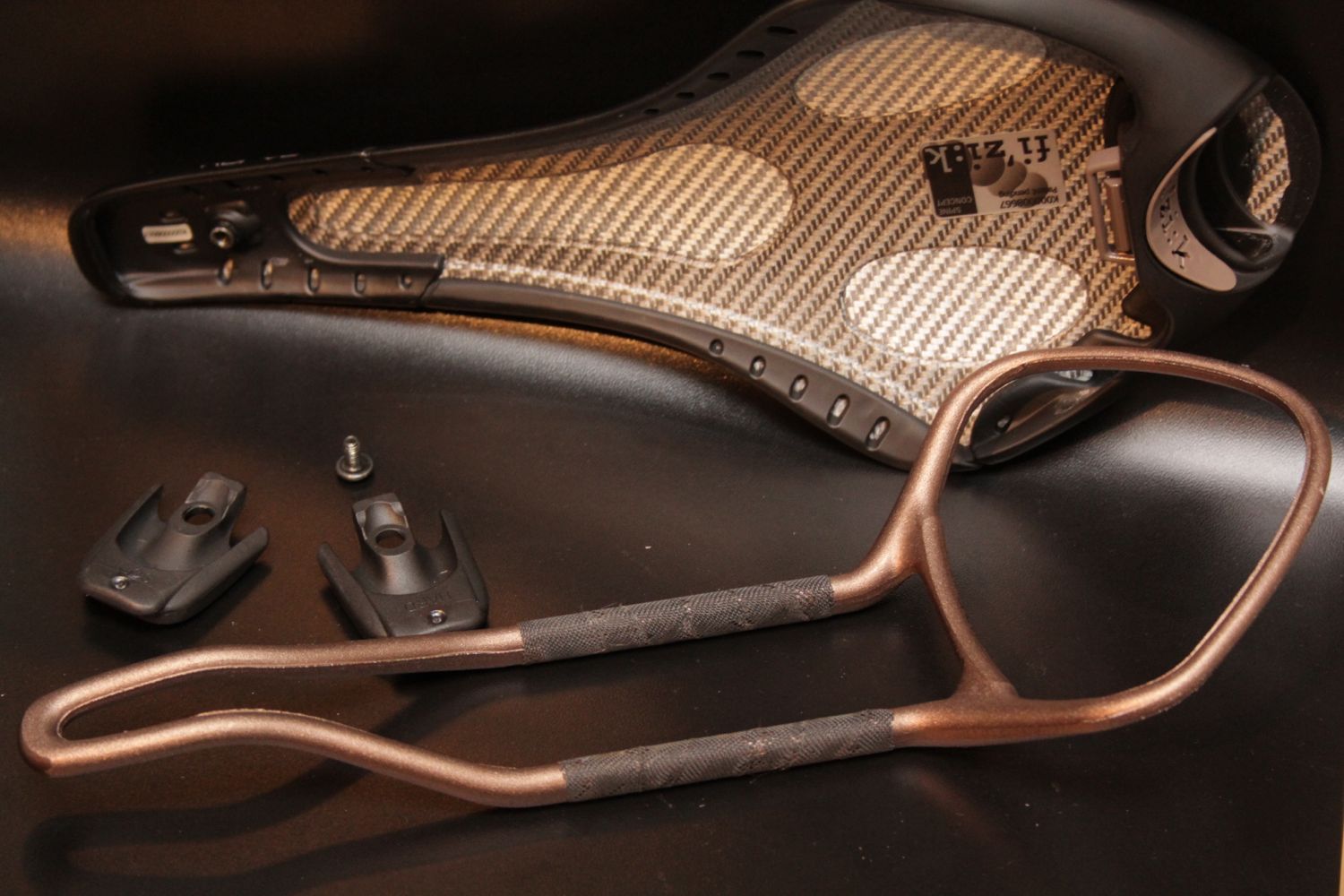Fizik Kurve Concept review
Fizik’s new Kurve Concept saddle line is a paradox. The Kurve saddles are at once a nakedly bold statement of modern material science and manufacturing, and yet the underlying design is perhaps more rooted in a 19th century approach than any other entry into the crowded market aside from Brooks. When just about every saddle introduced in the last 30 years relies mostly on foam padding to provide the majority of rider comfort, the composite base (shell) of the Fizik Kurve saddles are engineered to flex beneath the rider and in response to road input, just as a leather saddle like Brooks. Further, you can change the tension on the base to suit your preferences, but the Kurve saddles have tech style that suits today’s high end frames…….Also, these Fizik saddles weigh buttloads less than Brooks.
Each Kurve saddle is composed of three parts: the base, the rail, and a “tuner”. The shell is composed of varied layers of carbon composite, the distribution of laminate layers arranged in a way to determine flex. The Twin Flex flanks of the saddle are made of a plastic that is almost rubbery, to amply give way against the rider’s inner thigh while pedaling. And the shell is not devoid of padding; there is a thin sheath of microfibre-covered foam atop the base, but far less than typical performance saddles. The saddle’s flex does the rest, but because the saddle flexes so much the rails supporting the base most be stout. The Kurve saddles have a forged aluminium “Mobius” rail: stout yet low on mass. The rails hook into the rear underside of the base and then are secured at the nose by the “tuner”. Kurve saddles are provided with 2 tuners (hard & soft) that work by controlling the downward flex of the saddle. As the base flexes down, the horizontal length of the base naturally shortens somewhat. The hard tuner limits how much the base can shorten up on the very stiff rails, hence the base flexes less. The tuner can be swapped out at home in about a minute or so with a torx-head driver, to adjust the amount of flex in the saddle to rider preference, like a Brooks saddle. Unlike a Brooks which can be minutely adjusted with a threaded nut, the Fizik Kurve has just the two, discrete tunings.
Saturated with Bladerunner aesthetic, Fizik offers three different models in the Kurve product line, which correlate to their Spine Concept for saddles: Snake, Bull, and Chameleon. Each animal represents a style of rider or rather the way they sit on the saddle. The snake is a rider who is very flexible while the bull is more rigid in his posture; the chameleon is intermediate between the other two. In the standard road saddle range, the Snake saddle is the Arione series, the Bull the Aliante, and the Chameleon the Antares. Similarly, the Kurve line outwardly resemble their analogous counterparts in the standard lines. Since I am a devoted fan of the Arione, I chose the Kurve Snake.
At a glance, the Kurve Snake looks like the Arione with a much less pronounced tail. On closer inspection, the Kurve is much more domed over the centre, from nose to tail. I was a little worried since this is a feature I usually associate with saddles that don’t fit me. In fact, I believe I like the Arione precisely because it is so flat side-to-side as well as lengthwise. But it turns out that the saddle laterally flattens out when you sit on it. That flex feels well distributed along the length of the saddle, rather than having a localized sag in the middle. So the Kurve Snake does in fact feel very similar to the Arione. The difference is the tunability. Swapping out the tuners makes a big difference in the feel of the saddle. For me, I found that I preferred the soft tuner; it seemed to allow the saddle to give more on bumps. Perhaps the dome flattened out more too. To the eye, the Twin Flex flanks are seemingly as sharp as those on a Selle Italia SLR, but they nevertheless flex around your thighs without chafing.
I rode the Kurve Snake on cx bikes, daily commutes, and fixed gear. I wouldn’t actually recommend it for cyclocross as the saddle seemed a little bouncy to me over the ruts, and on remounts I had the impression that I was ricocheting off the saddle rather landing in it. Also, I rode this saddle in the stony mud of Enumclaw and crashed 3 times. It had nothing to do with the saddle, but all the mud jammed up into it made the saddle a little creaky once it dried out. Luckily I could totally disassemble the saddle and easily clean the dirt out while I was swapping tuners. What’s more, the saddle still looks new after all that abuse, but it really is too fine a thing to pummel on the cross courses. On my commutes, the saddle has turned out to be remarkably comfortable on the crap roads I typically roam; what seemed too bouncy on rutted cross courses felt more in sync with the sharper yet shorter jolts of the road.
The Kurve’s aluminium rails are a tall 9x7mm in cross section (like Fizik’s braided carbon rail saddles), which makes them a tricky fit in the cradles of a number of seatposts, in particular those accursed Bontrager and Specialized with side-loading clamps. Like most Fizik saddles, the Kurve saddles have an interface for Fizik’s line of “ICS” accessories like lights and saddle bags. The Kurve Snake sample weighed 224gr (actual) and all three models of the Kurve will retail for $270.
For whom is this saddle intended? The performance rider who wants to be able to fine tune the feel of the bike. Or the rider who wants a piece of art that uses the newest materials to enhance time-tested ideas.
